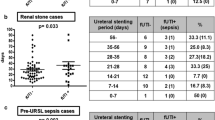Abstract
A randomized trial was conducted prospectively to evaluate the efficacy, related complications, and convalescence of emergent retrograde ureteroscopic management, instead of percutaneous nephrostomy for decompression of the collecting system in cases of sepsis associated with ureteral stone obstruction. A total of 107 patients undergoing ureteroscopic stone manipulation for ureteral stones completed the study protocol, 53 patients in the percutaneous nephrostomy group, and 54 patients in the emergent retrograde ureteroscopic management group. The primary end point was the time to normalization of WBC of 10,000/mm or less and temperature of 37.4 °C or less. The second end point was the comparison analgesic consumption, length of stay, and related complications. Statistical analysis was performed using SPSS® version 14.0.1. The Mann–Whitney U test, Chi square test, and fisher’s exact test was used as appropriate. The length of hospital stay (days) was 10.25 ± 3.53 and 8.24 ± 2.77 in the percutaneous nephrostomy group and emergent retrograde ureteroscopic management group, respectively, with significant difference (Table 2). However, patients in the emergent retrograde ureteroscopic management group had a significantly higher rate of s body temperature (°C). Meanwhile, the analgesic consumptions are 31.51 ± 11.16 and 40.00 ± 14.54 in the percutaneous nephrostomy group and emergent retrograde ureteroscopic management group, respectively, with significant difference. Our results show that it can be effectively and safely managed by retrograde ureteroscopic management combined with strong antibiotics in select clinical situations. Ureteroscopic management should no longer be considered a contraindication for the treatment of patients with sepsis associated with obstructing ureteral stones

Similar content being viewed by others
References
Amano T, Matsui F, Takashima H, Takemae K (2003) Analysis of patients with septic shock due to urosepsis brought on by ureteral calculi. Hinyokika Kiyo 49:1–4
Ramsey S, Robertson A, Ablett MJ et al (2010) Evidence-based drainage of infected hydronephrosis secondary to ureteric calculi. J Endourol 24(2):185–189
Lynch MF, Anson KM, Patel U (2008) Percutaneous nephrostomy and ureteric stent insertion for acute renal deobstruction. Consensus based guidelines. Br J Med Surg Urol 1(3):120–125
Thuroff JW, Gilfrich CP (2000) Percutaneous endourology and ureterorenoscopy. In: Tanagho EA, McAninch JW (eds) Smith’s general urology, vol 16. McGraw-Hill, New York, pp 121–139
Bone RC, Balk RA, Cerra FB, Dellinger RP, Fein AM, Knaus WA, Schein RM, Sibbald WJ (1992) Definitions for sepsis and organ failure and guidelines for the use of innovative therapies in sepsis. The ACCP/SCCM consensus conference committee, American College of Chest Physicians/Society of Critical Care Medicine. Chest 101:1644–1655
Türk C, Knoll T, Petrik A, Sarica K, Skolarikos A, Straub M, Seitz C (2015) Guidelines on urolithiasis. EUA, Arnhem, p 15
Lee WJ, Patel U, Patel S, Pillari GP (1994) Emergency percutaneous nephrostomy: results and complications. J Vasc Interv Radiol 5:135–139
Fowler JE Jr, Meares EM Jr, Goldin AR (1975) Percutaneous nephrostomy: techniques, indications and results. Urology 6:428–434
Ho PC, Talner LB, Parsons CL, Schmidt JD (1980) Percutaneous nephrostomy: experience in 107 kidneys. Urology 16:532–535
Stables DP (1982) Percutaneous nephrostomy: techniques, indications and results. Urol Clin N Am 9:15–29
Barbaric ZL, Wood BP (1977) Emergency percutaneous nephropyelostomy: experience with 34 patients and review of the literature. AJR 128:453–458
Lang EK, Price ET (1983) Redefinitions of indications of percutaneous nephrostomy. Radiology 147:419–426
Acknowledgments
Our Institutional Review Board of St. Martin De Porres Hospital in Chia-Yi city, within which the work was undertaken. All procedures performed in studies involving human participants were in accordance with the ethical standards of the institutional and/or national research committee and with the 1964 Helsinki declaration and its later amendments or comparable ethical standards.
Author information
Authors and Affiliations
Corresponding author
Ethics declarations
Conflict of interest
There is no conflict of interest in this study.
Rights and permissions
About this article
Cite this article
Wang, CJ., Hsu, CS., Chen, HW. et al. Percutaneous nephrostomy versus ureteroscopic management of sepsis associated with ureteral stone impaction: a randomized controlled trial. Urolithiasis 44, 415–419 (2016). https://doi.org/10.1007/s00240-015-0852-7
Received:
Accepted:
Published:
Issue Date:
DOI: https://doi.org/10.1007/s00240-015-0852-7



